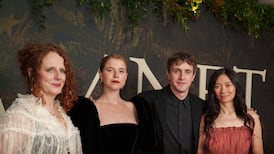Visual Arts: A series of interviews traces the transformation of the Irish visual arts world
This is the second volume in a series of interviews by Vera Ryan with significant figures in the Irish art world. Its timeliness is clear given that a quarter of those in volume one, which dealt with Irish art in general since 1960, are now dead (Noel Sheridan, Charles Haughey and Dorothy Walker), as are two in the current volume (Gordon Lambert and John Kelly).
The present book focuses on Irish visual art since 1940. It contains interviews with 12 people who have played significant roles in the evolution of the visual arts here. Given that nine of the previous volume's interviewees were also major contributors to the visual arts, we now have a substantial set of guided reminiscences fleshing out this fascinating corner of Irish cultural history.
Can we discern patterns in the dynamics of the visual arts in Ireland since 1940? To read these extended interviews as a whole is to listen to key players weaving their patch of an intricate web of personal and social connections. Taken together, they achieve an unforced coherence full of interesting insights and anecdotes. Artists, critics, gallery owners, collectors and administrators are all represented. The tone of the interviewees ranges from the elegiac through the reflective to self-regard worthy of Mr Toad.
Social class is clearly less significant today than it used be in the self- consciousness of the Irish visual arts world, nor is that world as small nor as male as it once was. The opportunities available are so much greater and more rewarding now. Poverty has retreated, as has social, moral and aesthetic conservatism. What is striking is how much of the good things about the pluralism of contemporary Ireland were long ago prefigured and nurtured in that small Irish arts world at a time when the going was often genuinely challenging and the living was tough.
The initial interviews are with two men who made lasting and contrasting contributions to the cultural life of Ireland. The question "Who was your tailor, Gordon?" elicits an immediate answer from Gordon Lambert, but the idea that that same question might be addressed to John Kelly is inconceivable. At the time of their interviews both men knew they were dying, and for that reason alone this book serves us well in recording authentic voices.
What John Kelly remembers of his student days in the College of Art must sound like a voice from another world to present-day students:
"There was that fear. In the college, when I was a student, you could walk into a room and see the whole class saying the Rosary. The fifties were terrible."
Very many people worked to transform the complex fabric of ideas and attitudes which moved that world-view towards our contemporary one. There was always humour in that struggle, as the Kelly interview shows when he recalls the inimitably discursive Noel Sheridan. Sheridan's directorial style was rather at odds with the grey orthodoxy of MBA-speak that has infiltrated much of Irish higher education: "Noel would say: 'I know what you mean, man, I wish I could help . . . You are pushing an open door but when push comes to shove and you are against the wall, there is ice in the heart.'"
Despite the smallness of Irish society, and the bijou nature of its visual arts world during the period covered, what is striking is how that world cradled and welcomed outside influences and contributions. Mary Cloake speaks of this.
Pat Scott and Barrie Cooke, to take just two particularly rich examples, supply detailed memories of just who did what, recalling the many people now in danger of being forgotten who contributed to the vibrancy of contemporary Ireland's artistic world.
One way of singling out some of those who played outstanding roles in supporting and advancing the visual arts in Ireland, especially in the period from the 1950s to the late 1980s, is to identify the names that keep cropping up across the interviewees' recollections, names that shine like neon nodes in the overall web.
Among them would be names like David Hendriks, Basil Goulding, Norah McGuinness, Gordon Lambert, Patrick Scott, Michael Scott, Peggy Butler, Leo Smith (John Taylor's mentor), the Waddingtons and Jack Yeats.
There are many more yet to be given credit, some included in the present book and more, hopefully, in a successor volume. This is a rich compendium of ideas that are of great social historical interest, but it also contains discussions of notions that animate contemporary art practice.
Brian Maguire and Jamshid Mirfenderesky, for example, both offer reflections on the personal and political functions of art. Homan Potterton, Hilary Pyle and Frances Ruane all offer insights into the National Gallery. Bruce Arnold offers insights into himself.
Vera Ryan has done great service in supplying us with such a readable purview of this seminal time in Irish cultural life.
Ciarán Benson is professor of psychology in University College Dublin and a former chairman of an Chomhairle Ealaíon/the Arts Council (1993-1998)
Movers & Shapers 2: Irish Visual Art 1940-2006 By Vera Ryan The Collins Press, 382pp. €20









